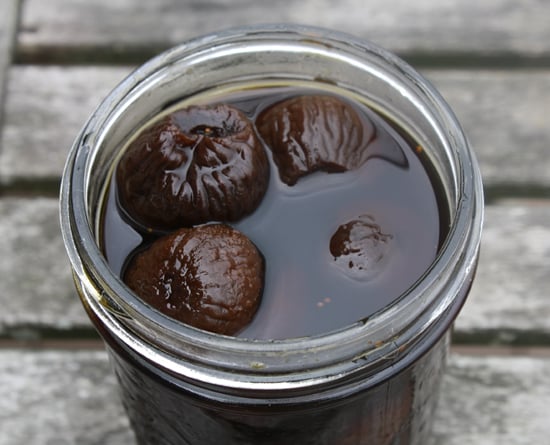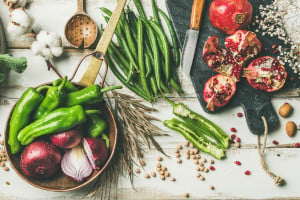In just a few short months, the weather in New York will chilly. Maybe even snowy. The fresh fruits I’ve been enjoying from local farms will be long gone.
Because I don’t look forward to this aspect of winter, I am taking time now to ensure I’ll still be able to taste a bit of summer in the cold months ahead by making homemade preserved fruits…
Last week I discussed some of the ways I like to preserve my fresh herbs for culinary and medicinal use during the winter, and I recently posted recipes for applesauce and pomegranate plum jam (I take this “stocking up stuff” very seriously, you see). Today I am going to show you a few more ways to preserve fruit.
These recipes are easy to make and they all keep beautifully…so go stock up at the farmer’s market or your favorite farm stand (and keep in mind that you don’t need beautiful fruit here, just ripe, so maybe you can even get a large bag or box of bruised fruits on sale). Organic is best, of course, but if that’s not possible, just wash your fruit well with a produce wash that removes unwanted chemicals.
Nectarine Jam
This is very similar to the pomegranate plum jam recipe in that it contains little sweetener (in this case, local apple cider and honey) and is pectin-free. This recipe makes about 3 cups of jam.
Ingredients:
10 ripe nectarines, pitted and roughly chopped (I didn’t peel mine, but you can if you’d like)
1 1/4 cups apple cider
1/4 cup honey
Directions:
Place nectarines and apple cider in a heavy saucepan and turn heat on high. Bring to a boil, and then reduce the heat to a simmer. Add the honey and mix well.
Allow to cook for about two hours, stirring every now and then to break up any large chunks of the fruit, and to make sure the bottom does not burn. As it cooks, the jam should become nice and thick. Without burning your tongue, taste a bit to make sure it is sweet enough for you. If not, add honey 1 Tb. at a time (or you could add 1-2 Tb. vanilla or lavender sugar, if you have it).
When it is sufficiently thick and sweet to your liking, take your jam off the heat and allow it to cool before spooning into jar(s).
Spicy Pear Chutney
Here is an unusual savory chutney recipe that works well with many types of fruit. I consulted recipes for lacto-fermented fruits from both Wild Fermentation and Nourishing Traditions: The Cookbook that Challenges Politically Correct Nutrition and the Diet Dictocrats
before I came up with this recipe. I was honestly skeptical about this one, but it’s really quite tasty, not to mention healthy. I plan to use mine alongside winter meat or poultry dishes; it is also nice as a savory applesauce alternative on potato pancakes.
Ingredients:
3-4 pears, cored and chopped (to equal about 3 cups of fruit; you could also try this with apples, plums, peaches, mango, pinapple, grapes, or papaya, or use a combination of fruit)
1/2 cup raisins
1/2 cup cashews or pecans, chopped
2 tsp. sea salt
juice of 1-2 lemons
1 leek or 1 onion or the bottoms from 3-4 green onions, finely chopped
1 Tb. (or more if you really like it) grated ginger
1-2 hot red chili peppers, fresh or dried, chopped (I used 1 dried ancho chili- plenty spicy for me)
1/2 cup (or more) filtered water
1 quart or 2 pint very clean glass jars with lids
Directions:
Mix fruit and nuts together in a bowl. Add salt, lemon juice, onion and spices, and mix well. Using a wooden spoon, pack tightly into jar(s). Pound down so that the fruit is quite compressed and the liquid rises. Add water as necessary to bring liquid level with the fruit mixture, which should be about 1 inch below the top of the jar (you need to leave a little room for expansion during fermentation). Keep at room temperature 2-4 days (open to check if it’s fizzy/bubbly as this will confirm fermentation) before transferring to the refrigerator and consume within 2 months.
Figs in Rum Syrup
If you have an excess of figs, or if you just happen to adore them like I do, this is a great way to save (and savor) them. The recipe comes from Nigella Lawson’s How to Be A Domestic Goddess. These are quite sweet and indulgent- perfect to have in your cupboard and bust open during the holidays. They are yummy with a little vanilla ice cream, homemade whipped cream, creme fraiche, or even Greek yogurt, or on their own garnished with some chopped toasted nuts. The recipe uses fresh figs but I have also made this with dried figs. If you don’t want to use the rum, feel free to leave it out and spice it up with some vanilla bean or extract, fresh or dried ginger, and some cinnamon instead. This recipe makes 1 quart.
Ingredients:
18-20 Black Mission Figs (fresh or dried)
1/2-1 1/2 cups sugar (Nigella states 1 1/2 cups sugar for the fresh figs; I decreased this to 1/2 cup for the dried)
approx. 2 1/2 -3 cups water
1/3 cup white rum (plus more as needed)
1 quart or 2 pint glass jars with lids
Directions:
Wash and dry the figs (be careful not to bruise the skins if using fresh figs). Place in a colander or bowl while you prepare the syrup.
Boil the sugar and water in a large pan; stir so that the sugar dissolves completely. Allow to boil gently for about 15 minutes.
Remove from the heat and add the rum and the figs. Bring the pot back to a simmer and allow to cook for about 1/2 hour, partially covered. Stir every now and then so that all of the figs are covered and cook equally.
With a slotted spoon, remove the figs to clean jar(s). Put the syrup back on the stove and allow to boil for about 10 minutes more, so it is further reduced. Remove from the heat and add the last 2 Tb. of rum and pour over the figs. If some of the figs are not immersed in liquid, add more rum so that they are all covered.
Cap tightly and allow to sit in a cool, dark place for at least 6 weeks. These should them be consumed within 6 months.
Preserved Lemons
Preserved lemons are big in North African cuisine and they are also used in Jewish dishes from the Sephardic tradition. Since you need to wait a full month for these to be ready, and I only started mine last week, I cannot vouch for their taste…I’m pretty excited about them though. I believe you can do this recipe with Meyer lemons, or limes, even oranges, as well.
A quick google search illustrated that there is no one way to make preserved lemons. While trying to decide how I would do mine, I checked into how a few of my favorite food bloggers have done it in the past…
Preserved Lemons by Elise Bauer/ Simply Recipes
Preserved Lemons by Heidi Swanson/101 Cookbooks
Preserved Lemons by David Lebovitz
…and I decided on the following, which is probably closest to David’s:
Ingredients:
6-8 lemons, dipped in boiling water for 10 seconds and then wiped clean to remove any wax (or just scrub your lemons very very well or use organic unwaxed lemons)
1 cup Kosher or sea salt
1/2 cup sugar (some recipes don’t use sugar, but I like the idea of using a little)
2 cinnamon sticks- optional
fennel seeds, coriander seeds, peppercorns- optional
olive oil-optional
1 qt glass jar with lid
Directions:
Trim the ends off your lemons and slice them into quarters. In a small bowl, mix your salt and sugar together, and pack some of this into the bottom of your jar.
Put your lemons into the salt/sugar mixture and mix well so that all the lemons are coated. Then pack the lemons into your jar.
Push down hard so you can fit as many in as possible, and then top off with some more of the salt/sugar mixture if there is room.
You may end up with a little of the salt/sugar left over; I mixed mine with a little coconut oil and used it as a body scrub :)

Lastly, I poured in some olive oil to bring the liquid over the lemons (some recipes suggest doing this; some don’t).
Next, every day for a month, make sure the cap is on tight and give your jar a couple of shakes to distribute any salt/sugar not in solution.
After a month’s time, the lemons will be ready for use; just rinse and chop the rinds and use them as you would lemon rind in any recipe, in Middle Eastern dishes, or check out David Lebovitz’ link above for a bunch of great ideas for how to use your preserved lemons. Store in the refrigerator and they should keep for 6 months or more.
Do you have a favorite method for preserving fruits? I’d love to hear about it!










